Introduction to make lakhs with cotton farming: Cotton is the world’s oldest commercial crop. It plays an important role in the industrial and agricultural economy of the country. It provides the basic raw material to the cotton textile industry. With the formation of the modern world of economic liberalization and globalization, our country can play an important role in the production and export of cotton.
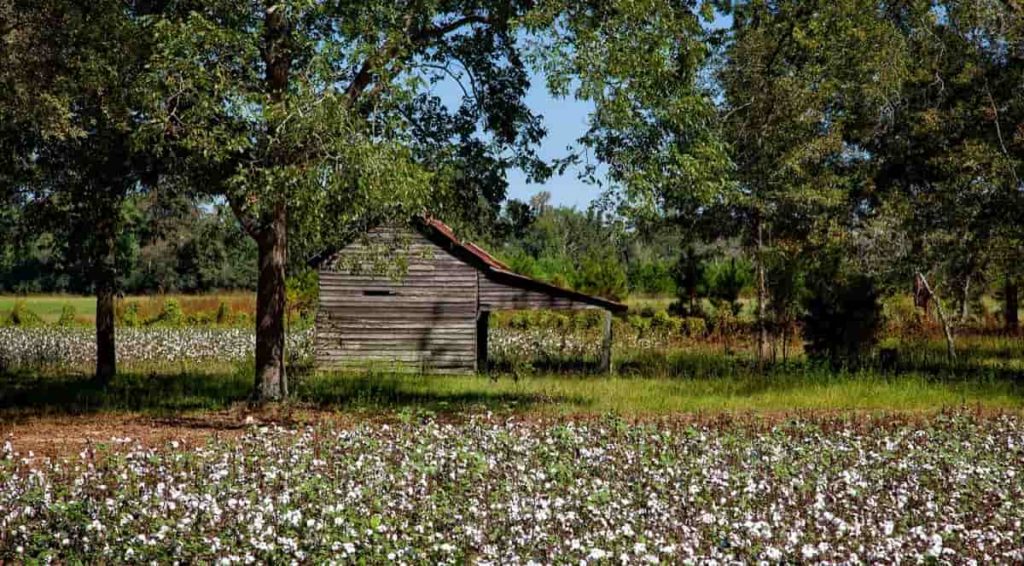
It is encouraging that cotton production has increased significantly in the last few years. The basics for growing any type of crop are land and water, but both are not required for cotton cultivation. Thanks to improved seed varieties and modern farming techniques, cotton plants are healthier, use less land and water, and have less environmental impact than in previous decades.
Cotton (Gossypium sp.) is one of the most important commercial crops playing a key role in the economy. Growing cotton under proper requirements and proper care will give profitable profit to the farmers. Management practices and favorable weather conditions can make a big difference in gross yield at the end of the season.
Guide on make lakhs with cotton farming, tips to increase profitability, varieties, seed rate, irrigation management, diseases, and how to harvest cotton
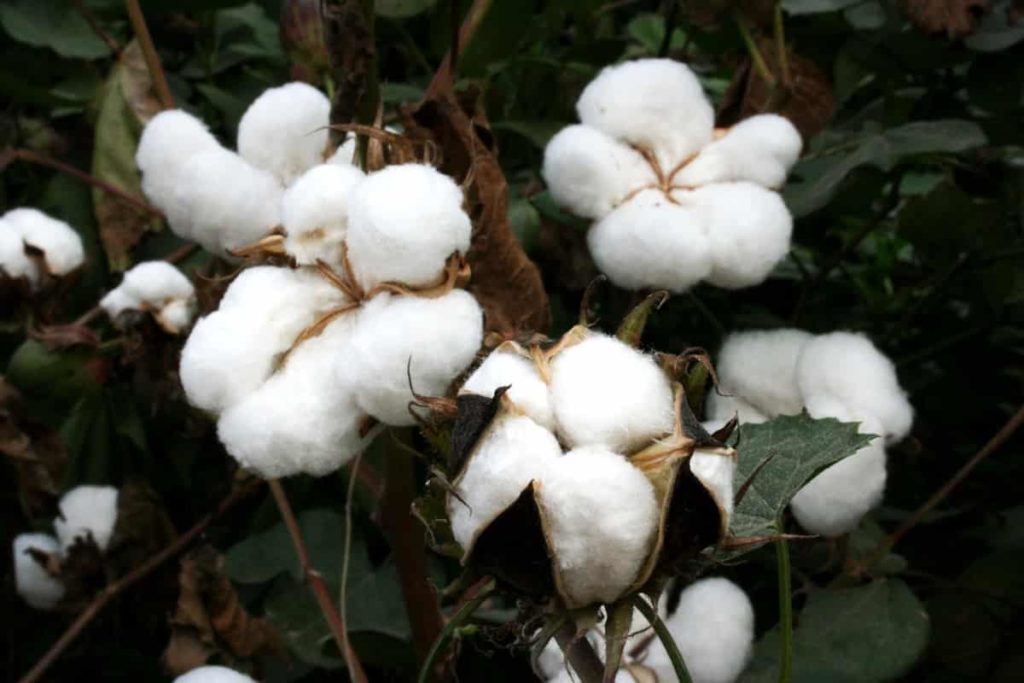
Tips for increasing cotton profitability
Climate requirement for cotton farming
Cotton is a tropical and subtropical crop. For successful germination of its seeds, a minimum temperature of 15°C is required. The maximum temperature range for plant growth is 21 – 27°C. It can withstand temperatures up to 43°C but is not good if the temperature drops below 21°C. During the fruiting period, hot days and cold nights are conducive to good speech and fiber development with large daily variations.
Suitable soil for cotton farming
The choice of soil in cotton farming is very important. The soil should be medium to deep (90 cm) black with good drainage. Cotton does not tolerate waterlogging. It is mainly grown as black cotton and dry crop in medium black soil. Irrigated cotton is grown in hard soil.
Cotton grows well in soils with good water potential. Good air and drainage are just as important as the crop cannot tolerate excess moisture and accumulation of water. The major types of soil suitable for cotton cultivation are alluvial, clay, and red sandy loam. Cotton is grown in both irrigation and rainfed conditions.
Sandy loam soil is the preferred soil for cotton cultivation whereas only sandy soil or clay soil alone is not suitable for cotton cultivation as there are seed germination problems. There are some other suitable lands for cotton cultivation – red soil, light red soil, ash soil, and saline soil.
Not suitable soils for growing cotton – alkaline soils, saline soils, soils with poor drainage.
Consider cover crops – If we’re going to have a profitable cotton production, the number one limiting factor is soil health or soil texture. If you are not already planting cover crops, consider getting cover crops on your radar for the future.
Different varieties of cotton
- Irrigated – DC H-32, JKH Y-1, H-4, H-6, Varlaxmi, Savita, Bikaneri Narma, RS T-9, RAJH H-16 (Maru Vikas), F-414, LH1556, Ganganagar agethi, H-777, RS875, TURAB, HY10, LRA-5166, etc,
- Rainfed – Y-1, JLH-168, LRA 5166, PKV Rajat, N H H-44, A H H-468, etc.,
- Gossypium hirsutum – upland cotton, Central America, Mexico, Caribbean
- Gossypium barbadense – known as extra-long-staple cotton, native tropical South American
- Gossypium arboreum – Tree cotton belongs to India and Pakistan.
- Gossypium herbaceum – Levant Cotton, belongs to South Africa and the Arabian Peninsula.
Picking the right cotton variety for profitability
This should be the first thing in the variety of cotton available to you: basically, it will help you to cut any non-profit varieties so that you do not waste time considering crops for which you do not have money. Will earn no matter how good they grow. Once you consider this, take a look at the quality of the fiber it will be determined by the genetics of the plant rather than the result of farming methods, so the data you see should be very accurate.
In case you miss this: Top 20 Seed Companies in India
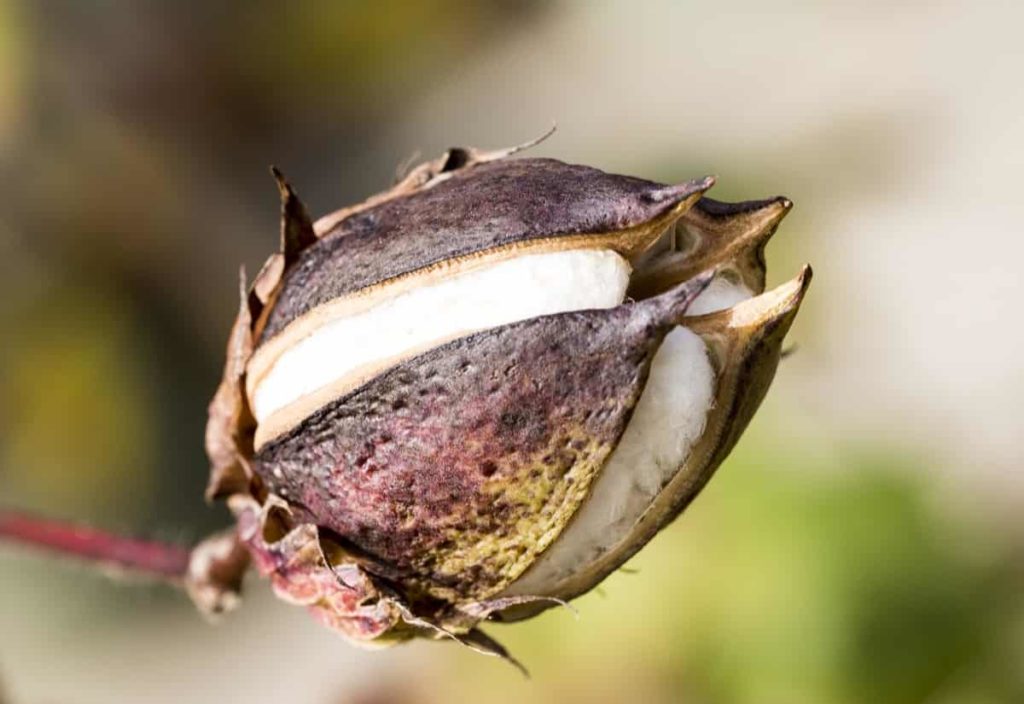
Tips for successful cotton farming
Land preparation – Cotton is sown on fields and furrows. The land is deeply plowed for irrigation of cotton, after which two harrowings are made. Different ridges and furrows for irrigated and rainfed cotton. For irrigation of cotton, shallow ridges should be prepared at a distance of 90 cm which will help in irrigation. Depending on the slope of the land, the length of the ridges should be 6-9 meters.
Proper planting conditions for cotton
Sowing time
The best time to sow is April – mid-May. To control mealybugs, sow Millet, Sorghum, Maize, and Jowar in the fields around the cotton crop. Avoid growing Tur, Peanuts, and Okra in and around the cotton field as these are shelters for insects. Circulation of cotton wheat is common but rotation with algae and cluster bean has been found to have a beneficial effect on the next crop of cotton.
Spacing
For American cotton, use a spacing of 75×15 cm in case of irrigation and 60×30 cm in case of rain-fed. Use 60×30 cm spacing for desi cotton for rain as well as irrigation.
Method of saowing
Use seed drill for sowing indigenous cotton whereas in the case of hybrid and Bt cotton the seed is doubled. Square planting is more beneficial than rectangular planting. Seed germination failure and seed death cause some gaps. It is necessary to fill this gap. Two weeks after sowing the weak/sick/damaged seedlings should be removed by placing a healthy seedling/hill.
Better management practices for cotton cultivation
Better management practices, technically, more environmentally friendly, promote the use of local resources, and improve input utilization efficiency. The methods, in addition to improved agricultural practices, can be broadly divided into some areas, namely;
Soil fertility management
Cotton-growing tracts are mainly characterized by low to medium levels of available Nitrogen (N) and Phosphorous (P) and medium to high levels of available Potassium (K).
Water management
Adoption of water conservation techniques such as drip irrigation and planting in rows of paired cotton (60 cm spacing compared to 90-120 cm) and 2 paired rows. Includes spaces of 120 cm in between. Other methods include abandonment of row irrigation by farmers and furrow application techniques that adopt flood irrigation irrespective of the length of the row.
Pest and disease management
Managing the risk of the cotton crop, especially pests and diseases, by setting appropriate technology and management practices. Insects that feed on plant structures that give direct yields, such as growing signs and fruiting structures, are usually the biggest problem in the cotton crop.
In case you miss this: Cotton Seed Germination Period, Temperature, Process
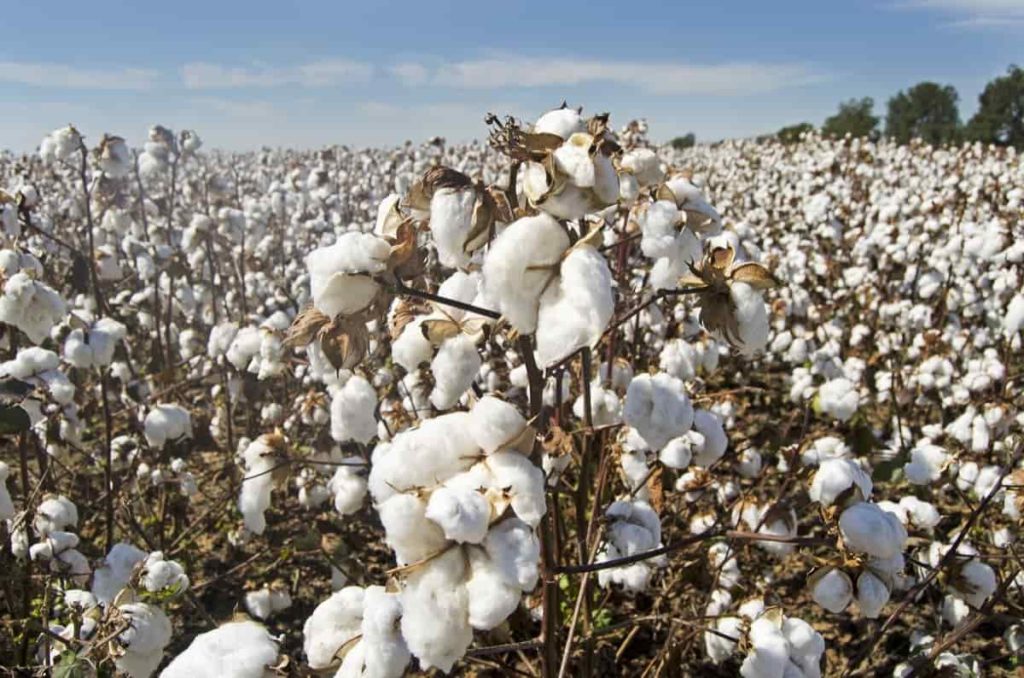
Proper harvesting
Harvesting time is an important factor in maintaining seed quality. Picking should be started only when the cotton is fully matured, that is when the drops begin to open.
Seed rate and seed treatment for cotton farming
Seed rates vary depending on variety selection, growing area, irrigation, etc. About 1.5 kg per acre for American cotton hybrids and 3.5 kg per acre for American cotton varieties. While for desi cotton hybrid@1.25 kg/acre and 3 kg/acre for desi cotton varieties.
Ensure proper seed treatment
Seed treatment is essential for good yield during monsoon. To protect your crops during the monsoon, treat your seeds with the best fungicides, pesticides, and nematicides. If you treat your soil and seeds with these chemicals, the yield is likely to increase.
Special cotton intercultural operation
- Thinning in cotton – Thinning is the process of removing excess seeds, excluding weak seedlings and off-varieties, by which the maximum population can be maintained for higher yields.
- Filling the gap in cotton – The process of filling the gap created by defective or non-germination of seeds after 7 days of sowing.
- Topping or nipping in cotton – The process of removing the upper part of 2-3 leaves to enhance the growth of lateral branches.
- Elimination of weeds in cotton cultivation – Weeding is done every 45, 60, and 90 days after planting.
Expert tips for some important issues related to successful cotton cultivation and avoidance of failures
- Nitrogen – Too much is bad, too little is bad – Too much nitrogen causes excessive growth and delay in maturity. This can be fatal and the goal should be to eliminate nitrogen or very little nitrogen by the end of August. The main goal is to have mature bolls before the winter season.
- Cotton needs warm soil to grow – Seeds should be protected from extremely low temperatures. When cotton is growing and if the soil temperature is less than 10 degrees, it can damage the plant for the whole season. Soil temperature should always be 16C or higher for cotton cultivation. Cotton should also be protected from severe monsoon conditions.
- Potash is very important for cotton – Potash is very important for cotton for various reasons. Potassium emissions are higher than nitrogen during filling. Low potash will delay the maturity of cotton and cause quality problems.
- In good humidity, plant one inch deep – Cotton should be soaked in one inch or one and a half inches in good moisture. It is a good idea to plant using a measuring stick as the chances of getting too deep are high.
- Start and stay clean – Always try to keep your cotton crop as clean as possible. Multiple layers of residual herbicides are recommended. Always research the best herbs and always use only them.
In case you miss this: Organic Cotton Production; Cultivation Practices
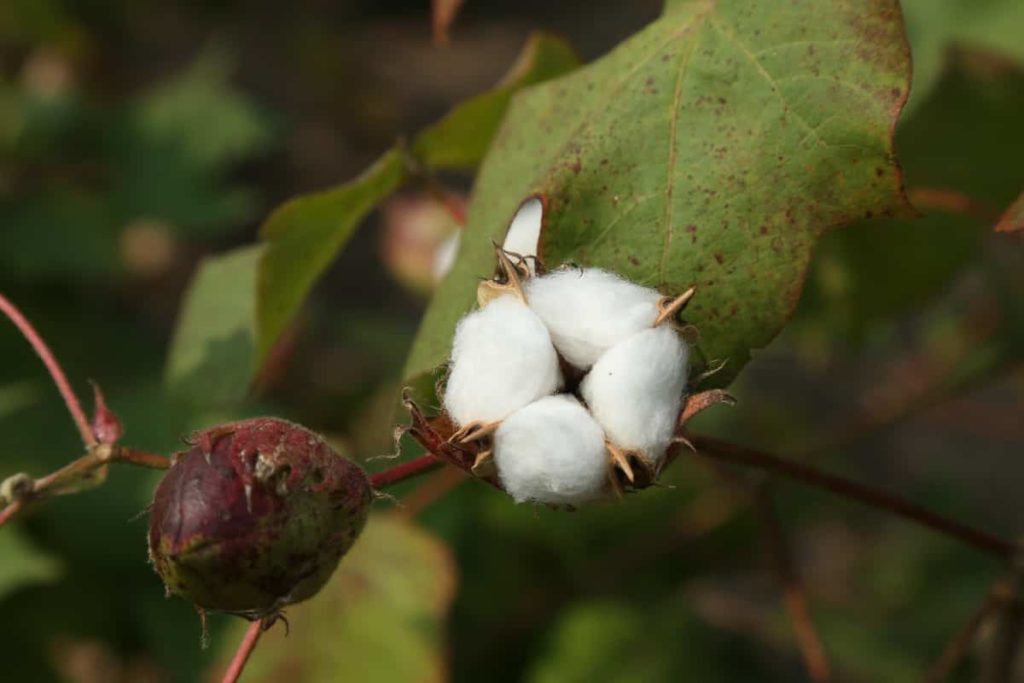
Nutrition and irrigation management for cotton farming
The cotton crop should be fertilized with FYM or compost at least once in 3 years (4-6 t / ac). Irrigated cotton needs more nutrients than a rain-fed cotton crop. Nitrogen fertilizer should be distributed in both rainfed and irrigated conditions.
In the case of cotton germination, square beginning, flower and boll formation, and boll development are important stages for irrigation. Irrigated cotton crop is usually sown after initial irrigation and light watering is given three or four days after the second germination. Later watering depends on the nature of the soil and climatic conditions. From the point of view of irrigation, flower and flower formation are important stages.
Pests and disease management for cotton farming
Fusarium wilt
Symptoms include yellowing, fading, and death of plants, and yellowing and fading of old plants. Treat acidic seeds with Carboxin or Carbendazim at 4 g / kg. After deep plowing in the summer during June-July, remove the debris of the affected plants from the soil and burn it. Apply increasing amounts of potash with a balanced dose of nitrogen and phosphate fertilizers. Apply a large amount of farmyard fertilizer or other organic fertilizer at 100t / ha. Spot drain with 0.05% benomyl or 0.1% carbendazim.
Alternaria leaf spot
Symptoms – Small, circular brown lesions on cotyledons and seed leaves that spread and produce a concentrated pattern. For controlling this problem, shake crop residues into the ground to reduce the level of molecules; Provide adequate irrigation and nutrients to plants, especially potassium; Sensitive crops may require the use of appropriate foliar fungicides.
Cercospora leaf spot
Symptoms of Cercospora leaf spot are circular red lesions on the leaves that grow and become white or gray in the middle. Wounds often have a pattern of concentric circles and have a red border. In the centers of the lesions dark gray ovules are formed which make them look dark gray. For controlling this problem, shake crop residues into the ground to reduce the level of molecules; providing adequate irrigation and nutrients to plants; Sensitive crops may require the use of appropriate follicle fungicides.
Bacterial blight
This bacterium can infect the cotton plant during all stages of development, affecting stems, leaves, bracts, and bolls. Treat acidic seeds with carboxyn or oxycarboxane at 2 g / kg or soak the seeds in 1000 ppm streptomycin sulfate overnight.
Armyworms
Holes in the bracts attached with bolls; excessive feeding by young larvae results in leaf skeletons. Young larvae are light green to yellow, while older larvae are usually dark green with a black and light line running along the body and pink or yellow underneath. For controlling this problem, organic methods of controlling Army pests include biological control through natural enemies that make the larvae parasitic and use Bacillus thuringiensis; chemicals are available for commercial control but many are available for home gardening do not provide adequate control over larvae.
Challenges facing the farmers who grow cotton
Cotton flowers and tufts falling problems
- Mix 2 grams of naphthalene acetic acid (NAA) in 10 liters of water and 200 liters of water is required for 1 acre. Spray this mixture twice when the flowers bloom and the next spray while the cotton tufts are forming.
- 5 ml neem oil + 1-liter water = spray for insects and moths.
- Yellow sticky cards for insects – You should use yellow sticky nets for flying plant insects. This will help in cotton cultivation, use this yellow sticky net for insects at the beginning of cotton cultivation to reduce the risk of pests and insects. Use 4 to 5 yellow boards in the 1-acre cotton farm.
- Redness in the leaves – Magnesium zinc foliar spray can be applied 50-80 days after planting.
In case you miss this: Cotton Cultivation Project Report, Farming Cost, Profit
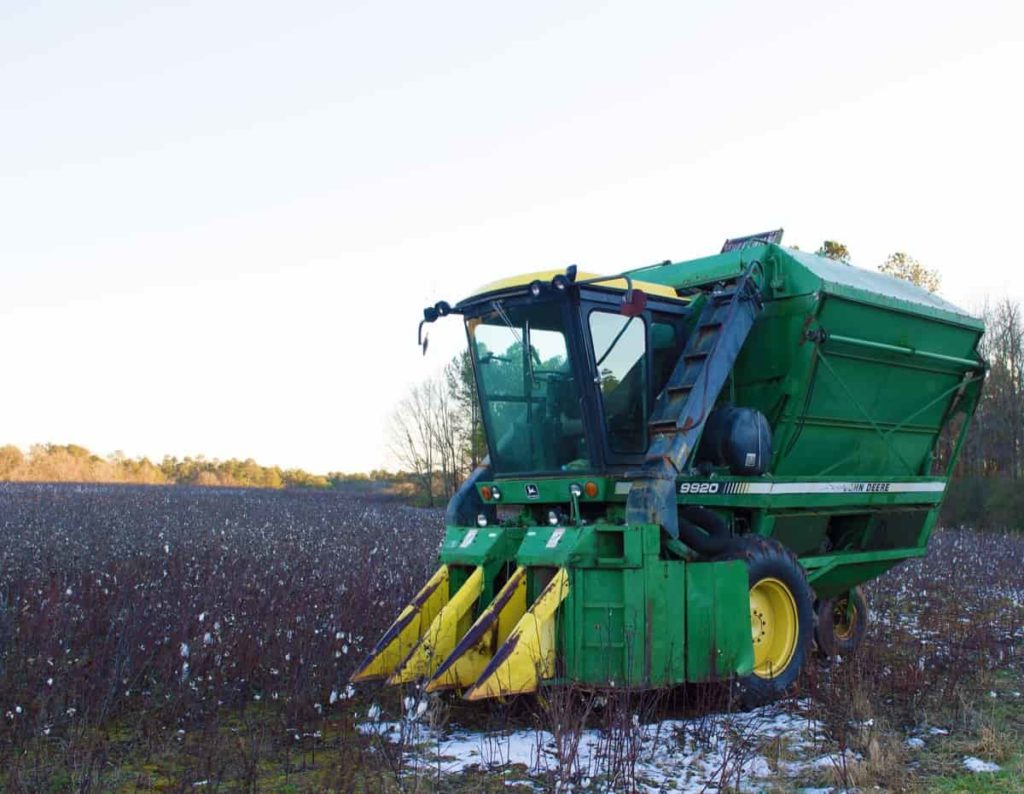
When and how to harvest cotton
Cotton will be ready for harvest six months after the date of planting. There will be a lot of harvesting in the morning till 10 a.m. The bolls have to be picked up manually without any dust. Good cotton and bad cotton should be kept separate. The harvested cotton should be dried to get proper quality. Store the cotton well after drying.
Frequently asked questions about cotton farming
How is cotton propagated?
Cotton grows from seeds and seedlings.
How many cotton plants per acre?
Depending on the spacing, however, you can plant about 70,000 cotton plants per acre.
How long does it take to grow cotton?
The cotton is fully mature and ready for harvest after 6 weeks of planting. Once the vines burst, farmers can prepare the cotton plants for harvesting.
Which soil is best for the cotton crop?
Cotton grows well in soils with good water potential. Good air and drainage are just as important as the crop cannot tolerate excess moisture and accumulation of water. The major types of soil suitable for cotton cultivation are alluvial, clay, and red sandy loam.
Is cotton planted every year?
The cotton plant is a perennial by nature, but it is grown annually because commercial crops must be turned under them every year immediately after harvest to help prevent disease and fight weeds. The flower on the plant is very beautiful and belongs to the hibiscus family.
- Economical Aquaculture: A Guide to Low-Budget Fish Farming
- 15 Common Planting Errors That Can Doom Your Fruit Trees
- How to Make Houseplants Bushy: Effective Tips and Ideas
- Innovative Strategies for Boosting Coconut Pollination and Yield
- Pollination Strategies for Maximum Pumpkin Yield
- The Complete Guide to Chicken Fattening: Strategies for Maximum Growth
- Natural Solutions for Tulip Problems: 100% Effective Remedies for Leaf and Bulb-Related Issues
- Revolutionizing Citrus Preservation: Towards a Healthier, Greener Future
- Natural Solutions for Peony Leaf and Flower Problems: 100% Effective Remedies
- Maximizing Profits with Avocado Contract Farming in India: A Comprehensive Guide
- Natural Solutions for Hydrangea Problems: 100% Effective Remedies for Leaf and Flowers
- The Ultimate Guide to Choosing the Perfect Foliage Friend: Bringing Life Indoors
- From Sunlight to Sustainability: 15 Ways to Use Solar Technology in Agriculture
- The Ultimate Guide to Dong Tao Chicken: Exploring from History to Raising
- The Eco-Friendly Makeover: How to Convert Your Unused Swimming Pool into a Fish Pond
- Mastering the Art of Delaware Chicken Farming: Essentials for Healthy Backyard Flocks
- 20 Best Homemade Fertilizers for Money Plant: DIY Recipes and Application Methods
- How to Craft a Comprehensive Free-Range Chicken Farming Business Plan
- Brighten Your Flock: Raising Easter Egger Chickens for Beauty and Bounty
- How to Optimize Your Poultry Egg Farm Business Plan with These Strategies
- Subsidy for Spirulina Cultivation: How Indian Government Schemes Encouraging Spirulina Farmers
- Ultimate Guide to Raising Dominique Chickens: Breeding, Feeding, Egg-Production, and Care
- Mastering the Art of Raising Jersey Giant Chickens: Care, Feeding, and More
- Ultimate Guide to Raising Legbar Chickens: Breeding, Farming Practices, Diet, Egg-Production
- How to Raise Welsummer Chickens: A Comprehensive Guide for Beginners
- How to Protect Indoor Plants in Winter: A Comprehensive Guide
- Ultimate Guide to Grow Bag Gardening: Tips, Tricks, and Planting Ideas for Urban Gardeners
- Guide to Lotus Cultivation: How to Propagate, Plant, Grow, Care, Cost, and Profit
- Agriculture Drone Subsidy Scheme: Government Kisan Subsidy, License, and How to Apply Online
- Ultimate Guide to Raising Araucana Chickens: Breed Profile, Farming Economics, Diet, and Care
- Bringing Hydroponics to Classroom: Importance, Benefits of Learning for School Students
- Ultimate Guide to Raising Polish Chickens: Breed Profile, Farming Economics, Diet, and Care
- Ultimate Guide to Raising Australorp Chickens: Profile, Farming Economics, Egg Production, Diet, and Care
- Silkie Chicken Farming: Raising Practices, Varieties, Egg Production, Diet, and Care
- Sussex Chicken Farming: Raising Practices, Varieties, Egg Production, Diet and Care
- Homemade Feed Formulations for Livestock: Discover Cost-effective Starter to Finisher Feed Recipes